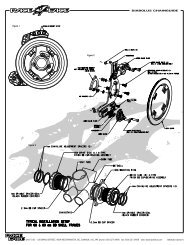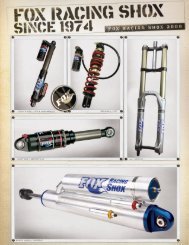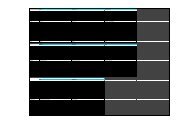Create successful ePaper yourself
Turn your PDF publications into a flip-book with our unique Google optimized e-Paper software.
say goodbye to road parts on yoUr moUntain bike.<br />
fox and shimano developed the all-new 15Qr system to<br />
improve the lives of cross-coUntry and all-moUntain<br />
riders everywhere. the tool free 15Qr thrU axle makes<br />
for fast wheel changes and increased stiffness to weight<br />
ratio. the 15Qr offers a lighter system weight than a 20mm<br />
thrU axle and greater stiffness than a standard 9mm open<br />
dropoUt. welcome to the new world order.<br />
15 MM x 100 MM<br />
hUB<br />
nOn disC side<br />
sPOKe FlanGe<br />
20 MM x 110 MM<br />
hUB<br />
stiffness/strength<br />
100 MM<br />
60 MM<br />
FlanGe width<br />
110 MM<br />
disC side<br />
sPOKe FlanGe<br />
15Qr<br />
ROtOR MOUntinG<br />
sURFaCe<br />
20Qr<br />
Our thoughts on wheel stiFFness/strenGth:<br />
Disc brake spacing, mounting geometry, and alignment are a locked standard that must be complied with. Current disc brake<br />
rotor spacing is defi ned from the center plane of the wheel, not from the dropout face. Therefore, 110mm spacing doesn’t do<br />
anything for wheel strength or stiffness. The non disc side fl ange of the wheel hub is optimized to be as close to the non disc<br />
side of the fork leg already…whether the dropout spacing is 100mm, or 110mm. The disc side wheel hub fl ange has to provide<br />
clearance to the brake rotor, which is frozen in its placement, regardless of dropout spacing dimensions, due to current disc<br />
brake rotor placement dimensions and standards. Therefore, due to the use of disc brakes and the need to place brake rotors<br />
where they are expected to be, dropout spacing does not translate to wider wheel hub fl ange spacing. Making the entire fork<br />
wider (and registering the disc brake rotor placement off of the face of the dropout which would require a new disc brake<br />
mounting standard), not just the dropout spacing, would allow for a potentially stronger wheel. But this would make the overall<br />
fork much heavier due to the wider crown and fork brace. Since DH wheels have the same hub fl ange spacing as a 15X100 hub,<br />
and since DH wheels are deemed plenty strong already, we chose to maintain our overall fork width to our current spacing, take<br />
advantage of the weight savings listed above, and do all this with no theoretical wheel strength difference between a 15X100 VS<br />
a 20X110.<br />
Our thoughts on aXle stiFFness:<br />
A properly designed thru axle system is going to provide<br />
better torsional and transverse shear performance than an open<br />
dropout axle system. FOX and Shimano chose the 15X100 as the<br />
appropriate blend of weight, stiffness and packaging for the XC,<br />
Trail, and light duty All Mountain applications. Axle diameter plays<br />
a big theoretical role in predicting system stiffness. In practice<br />
however, since there is little to no unsupported axle in any bicycle<br />
thru axle system, the axles themselves end up more in shear and in<br />
tension, where cross sectional area and closure method…not<br />
diameter…are the key design parameters.<br />
weight<br />
Our thoughts on<br />
aXle diaMeter:<br />
It is true that a 15mm<br />
diameter axle is about the<br />
same weight as a 20mm<br />
diameter axle per length.<br />
The 15mm axle will have a<br />
thicker wall thickness than the<br />
20mm axle when designed to<br />
handle similar loads. However, the<br />
100mm width means 10mm less<br />
axle length…so the 15 X 100 system<br />
is lighter than the 20 X 110 system.<br />
FOX and Shimano calculated this<br />
to be a 5g savings.<br />
Our thoughts on hub weiGhts:<br />
An optimized hub for a 15mm axle will be lighter<br />
than an optimized hub for a 20mm axle. The bearings<br />
are smaller for the 15mm axle, so the hub shell can be<br />
smaller for the 15mm axle. FOX and Shimano calculated<br />
this to be a 55g savings.<br />
Our thoughts on drOpOut desiGn:<br />
The dropout material supporting the axle on the lower<br />
leg is of a smaller diameter for a 15mm axle than it is for<br />
a 20mm axle. FOX calculated this to be an 11g savings.<br />
weiGht cOnclusiOn: FOX and Shimano calculated<br />
the 15X100 axle system weight to be a 5g + 55g + 11g =<br />
71g savings as compared to a 20x110 axle system weight.<br />
15 percent<br />
InCrease In torsIonaL stIFFness<br />
25 percent<br />
InCrease In transverse shear stIFFness<br />
Our thoughts on pacKaGinG:<br />
We wanted the axle lever to be as tucked in as possible when in the properly adjusted and installed position. 110mm dropout<br />
spacing would put the axle lever further outside the envelope of the lower leg tube. The 100mm spacing allows for better<br />
installed lever packaging.<br />
32<br />
CHassIs<br />
crowns<br />
For 2009 we redesigned and optimized<br />
all 32mm crowns: F80-100,<br />
F120, F29 and the new 140 Crown for<br />
both the standard 1 1/8 steerer and the<br />
new 1.5 tapered steerer.<br />
the new forging yields a lighter and<br />
stronger overall fork.<br />
crown + steerer<br />
new lighter 140mm web-brace lower<br />
this form-fi t lower leg wraps around the seal fl anges for a<br />
lighter casting. revised internal machining process results in<br />
lower friction throughout the stroke.<br />
new designs are optimized to produce<br />
greatest strength to weight ratio.<br />
• Lighter weight<br />
• Increased ultimate fork strength<br />
• Increased fork bending stiffness<br />
• Increased torsional stiffness<br />
9 10








